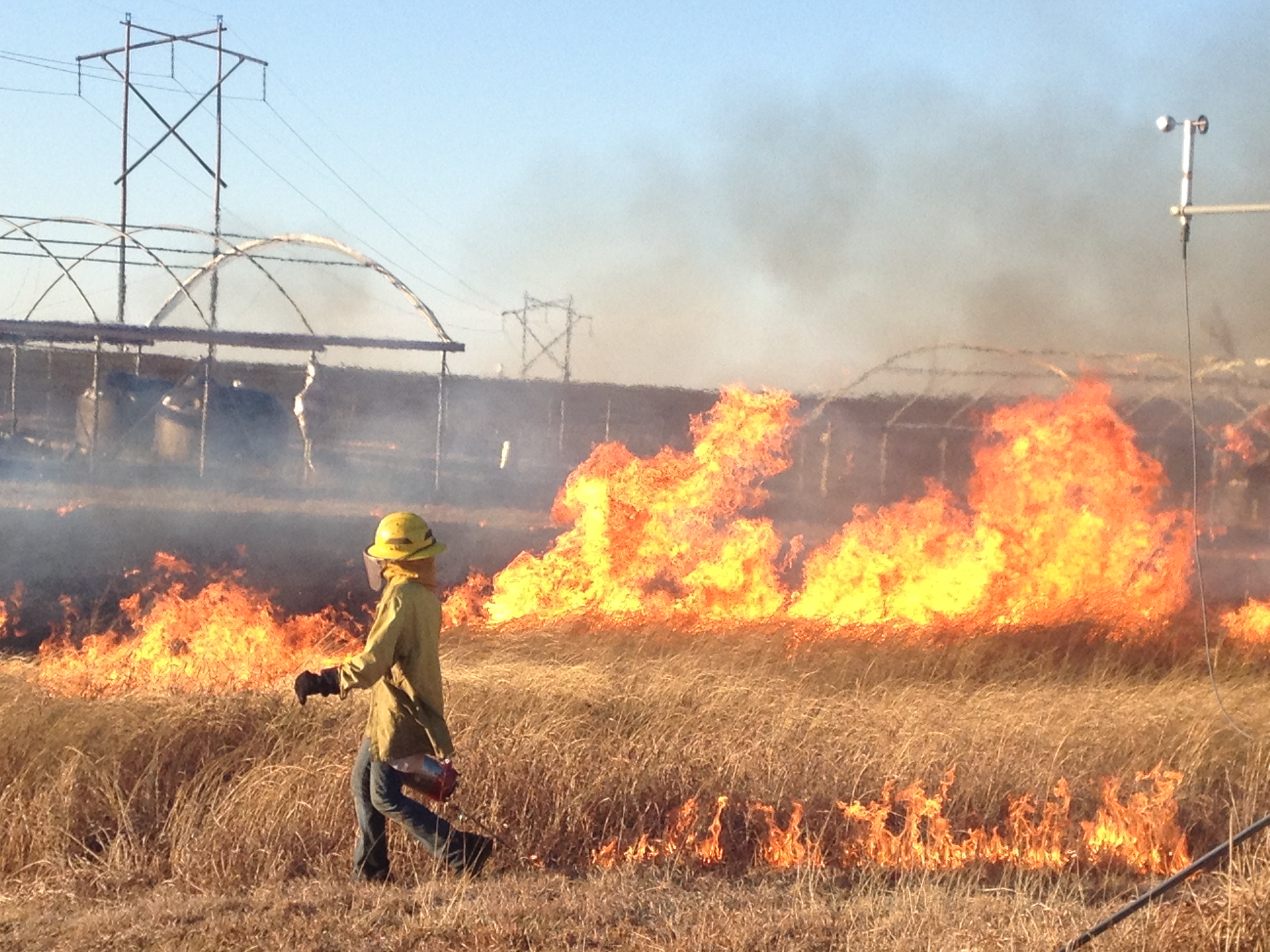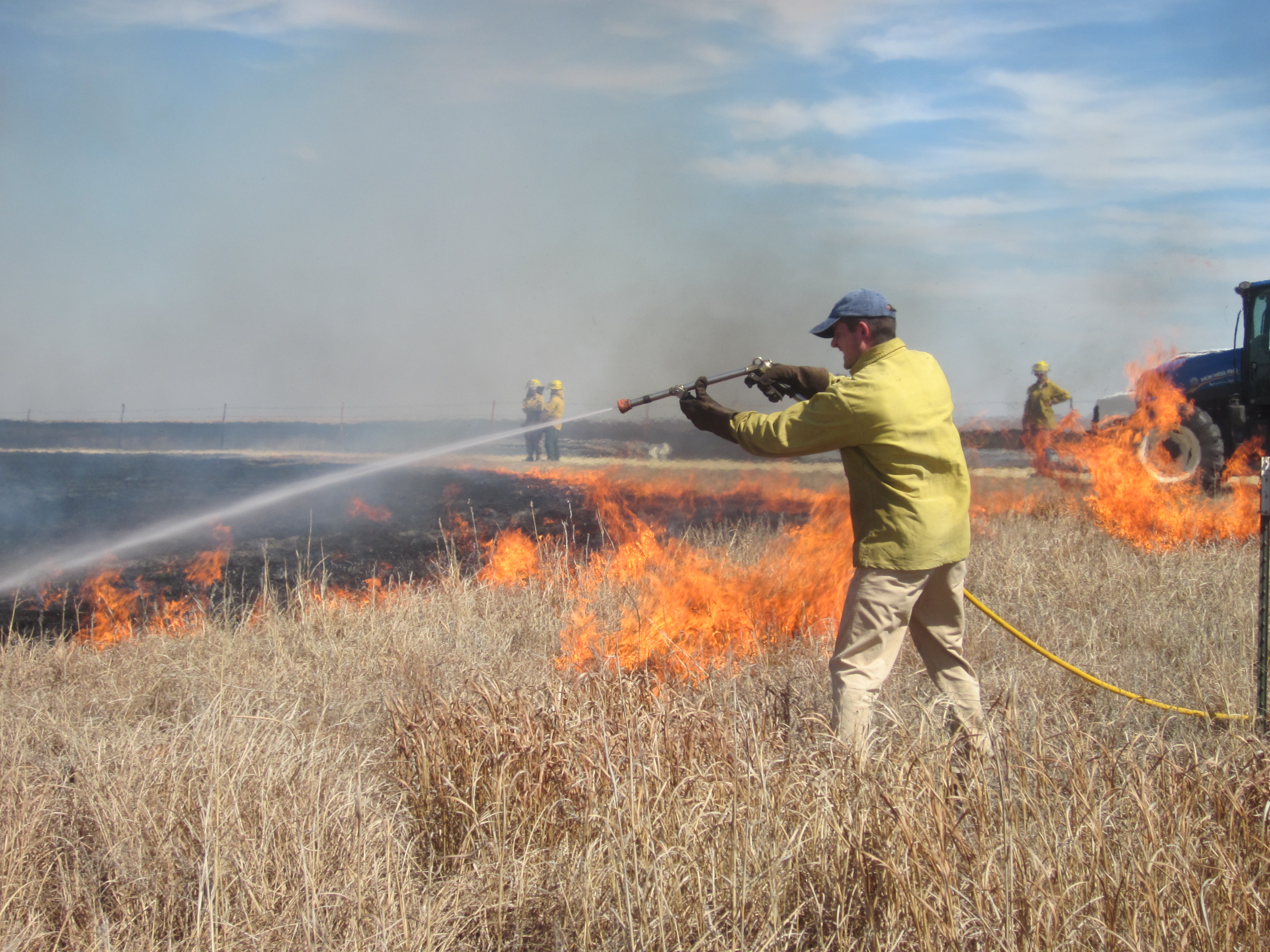
Setting Fire to the Prairie
By Andrew Felton
 Fire is one of many disturbances that ecosystems naturally experience. While often viewed negatively, fire is also necessary for the maintenance of many ecosystems and their properties, and thus is of special interest to ecologists. The tallgrass prairie is a prime example of an ecosystem that depends on fire for its persistence. Fire provides a competitive advantage to native grass species, restricting the encroachment of trees and other plant species. As fire clears dead plant material, grasses can grow quickly to paint the landscape green once again. This rich, new plant growth attracts ungulates such as the endemic bison to recently burned areas. Historically, Native Americans recognized the benefits of fire, including its influence on bison and instituted burning as a common practice. To this day prescribed burning is a common management practice in the tallgrass prairie, both for conservation purposes and range management.
Fire is one of many disturbances that ecosystems naturally experience. While often viewed negatively, fire is also necessary for the maintenance of many ecosystems and their properties, and thus is of special interest to ecologists. The tallgrass prairie is a prime example of an ecosystem that depends on fire for its persistence. Fire provides a competitive advantage to native grass species, restricting the encroachment of trees and other plant species. As fire clears dead plant material, grasses can grow quickly to paint the landscape green once again. This rich, new plant growth attracts ungulates such as the endemic bison to recently burned areas. Historically, Native Americans recognized the benefits of fire, including its influence on bison and instituted burning as a common practice. To this day prescribed burning is a common management practice in the tallgrass prairie, both for conservation purposes and range management.
In Spring of 2015, I found myself in the rolling Flint Hills of northeastern Kansas, the largest expanse of native tallgrass prairie in North America. Nested within this sea of grass is the Konza Prairie Biological Station, a tallgrass prairie reserve dedicated to ecological research and operated by Kansas State University. As part of the research program, different frequencies (e.g., 1 vs. 4 years) and timing (e.g., spring vs. summer) of fire have been instituted to observe the effects on the ecosystem. As luck would have it—and as a consequence of my own research— I happened to be there during the annual spring burn throughout the flint hills, signaled by the dark clouds of smoke in the distance.
The anticipation before a prescribed burn was palpable. Much discussion of ‘will we or won’t we’ occurred from the day prior into the morning of the burn. It wasn’t until the morning of that we received the thumbs up from the fire coordinator. The wind appeared to be holding up, and we hoped the morning dew would subside to allow the dead plant material to catch fire. With the all-clear signal, a large congregation of professors, graduate students, technicians and volunteers slowly gathered within the fire station at Konza. The fire coordinator gave us the rundown for the days’ operation, designating individuals to tackle different tasks and watersheds within the prairie. I stood there both curious and intimidated at the thought of setting fire to a landscape. I threw on a fire jacket thinking maybe I could be taken seriously with the right outfit. I knew virtually nothing of the logistics of prescribed burning, yet here I was in the first line of defense.
We began our work in an upland watershed of the Konza. As the fire technician began to  light the grass, the ecosystem almost immediately set ablaze, the fire consuming the dead plant material across the landscape. The crew—located in the upland Extreme Drought in Grasslands Experiment (EDGE) sites which are managed by Drs. Melinda Smith and Alan Knapp of Colorado State University—stood by to protect the highly sensitive soil moisture and soil CO2 sensors. Naively (or heroically?), I volunteered to track down the flames to put them out. As the fire consumed the prairie I marched in towards the flames and sprayed down the sensors, with the supreme heat becoming increasingly clear to me. The operation was fast-paced, adrenaline infused, and ultimately a high-risk situation for the equipment of the experiment.
light the grass, the ecosystem almost immediately set ablaze, the fire consuming the dead plant material across the landscape. The crew—located in the upland Extreme Drought in Grasslands Experiment (EDGE) sites which are managed by Drs. Melinda Smith and Alan Knapp of Colorado State University—stood by to protect the highly sensitive soil moisture and soil CO2 sensors. Naively (or heroically?), I volunteered to track down the flames to put them out. As the fire consumed the prairie I marched in towards the flames and sprayed down the sensors, with the supreme heat becoming increasingly clear to me. The operation was fast-paced, adrenaline infused, and ultimately a high-risk situation for the equipment of the experiment.
One successful burning down and one to go: we headed down to the lowlands to burn around another experiment. This time, I get to operate the fire torch. The fire coordinator put the drip torch in hand, and ignited it. Ultimately, what this meant was that it was time to MOVE: fire has no patience for anything in its path. As I dragged the drip torch behind me, a trail of fire increasingly gained momentum as the flames gained intensity. As the flames began to rise, they converged at the middle, forming a blast of energy with flames reaching 20-30 feet in height, and disappearing 30 seconds later. What remained was a black, smoky landscape seemingly devoid of life.
A few weeks later I returned to see speckles of green emerging throughout the landscape, as the grasses had received their cue; the growing season was beginning. It was through this experience that the role of fire as a powerful and ultimately regenerative force of nature was clarified to me, as well as its unique service that allows the persistence of the endangered tallgrass prairie ecosystem.
Andrew Felton is a PhD student with Dr. Melinda Smith. His research focuses on how human induced alterations to grassland communities impact their structure and function.